Threats to Validity in Research Studies
VerifiedAdded on 2020/03/01
|10
|2171
|23
AI Summary
This assignment requires a critical analysis of the threats to internal and external validity within a specific randomized controlled trial (RCT) focusing on the use of Garcinia cambogia for weight loss in obese women. Students must identify potential biases, limitations, and sources of error that could affect the study's results. Furthermore, they need to propose strategies to mitigate these threats and ensure the reliability and generalizability of the findings.
Contribute Materials
Your contribution can guide someone’s learning journey. Share your
documents today.
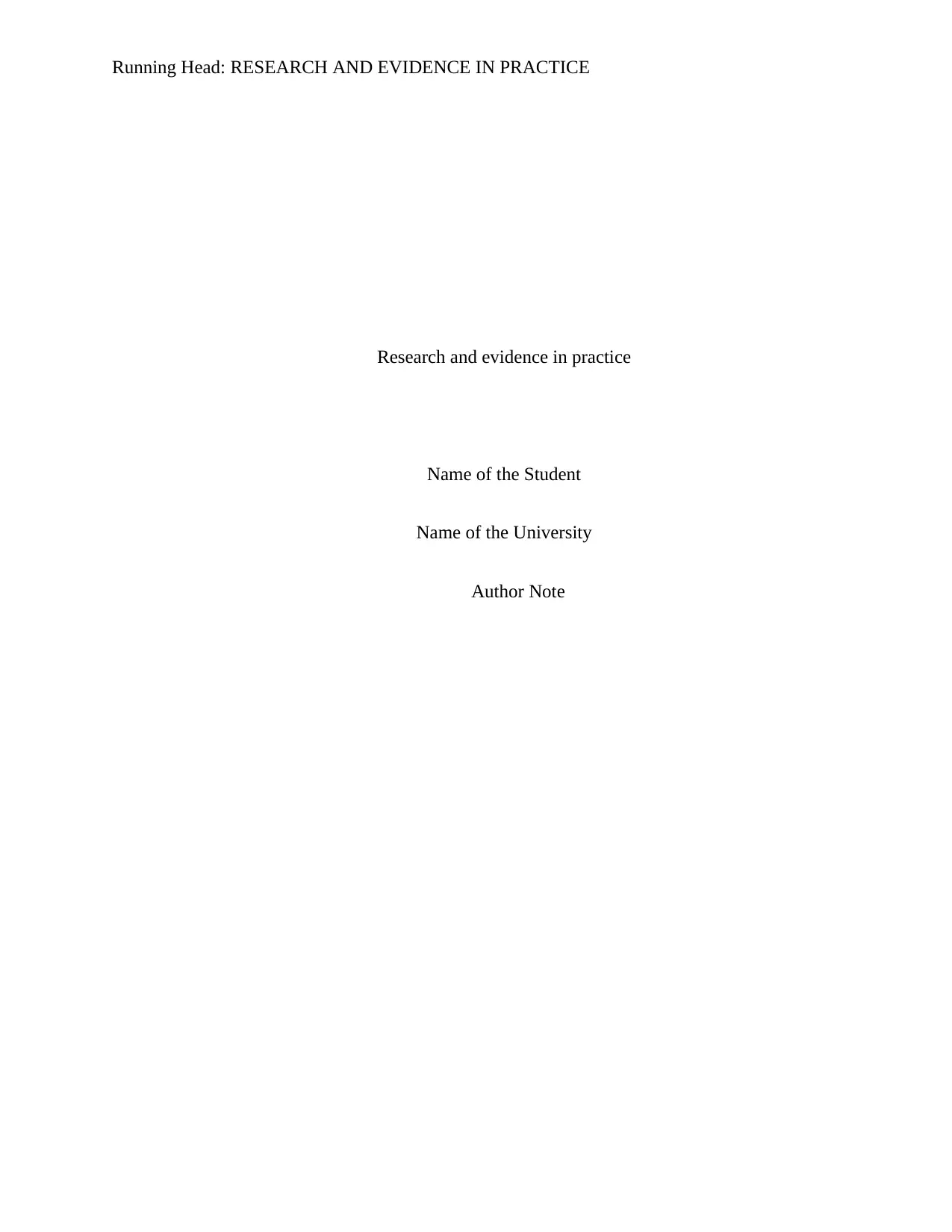
Running Head: RESEARCH AND EVIDENCE IN PRACTICE
Research and evidence in practice
Name of the Student
Name of the University
Author Note
Research and evidence in practice
Name of the Student
Name of the University
Author Note
Secure Best Marks with AI Grader
Need help grading? Try our AI Grader for instant feedback on your assignments.
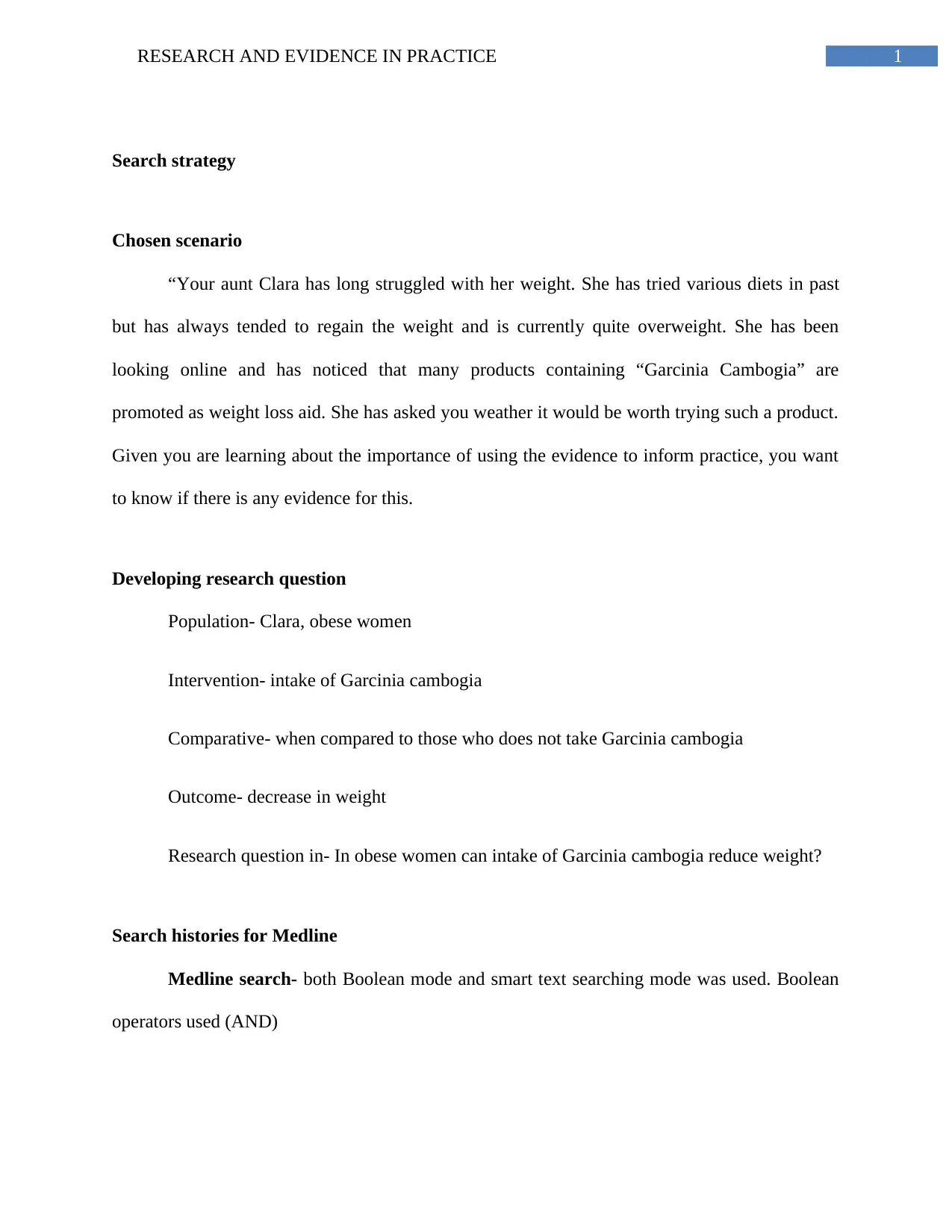
1RESEARCH AND EVIDENCE IN PRACTICE
Search strategy
Chosen scenario
“Your aunt Clara has long struggled with her weight. She has tried various diets in past
but has always tended to regain the weight and is currently quite overweight. She has been
looking online and has noticed that many products containing “Garcinia Cambogia” are
promoted as weight loss aid. She has asked you weather it would be worth trying such a product.
Given you are learning about the importance of using the evidence to inform practice, you want
to know if there is any evidence for this.
Developing research question
Population- Clara, obese women
Intervention- intake of Garcinia cambogia
Comparative- when compared to those who does not take Garcinia cambogia
Outcome- decrease in weight
Research question in- In obese women can intake of Garcinia cambogia reduce weight?
Search histories for Medline
Medline search- both Boolean mode and smart text searching mode was used. Boolean
operators used (AND)
Search strategy
Chosen scenario
“Your aunt Clara has long struggled with her weight. She has tried various diets in past
but has always tended to regain the weight and is currently quite overweight. She has been
looking online and has noticed that many products containing “Garcinia Cambogia” are
promoted as weight loss aid. She has asked you weather it would be worth trying such a product.
Given you are learning about the importance of using the evidence to inform practice, you want
to know if there is any evidence for this.
Developing research question
Population- Clara, obese women
Intervention- intake of Garcinia cambogia
Comparative- when compared to those who does not take Garcinia cambogia
Outcome- decrease in weight
Research question in- In obese women can intake of Garcinia cambogia reduce weight?
Search histories for Medline
Medline search- both Boolean mode and smart text searching mode was used. Boolean
operators used (AND)
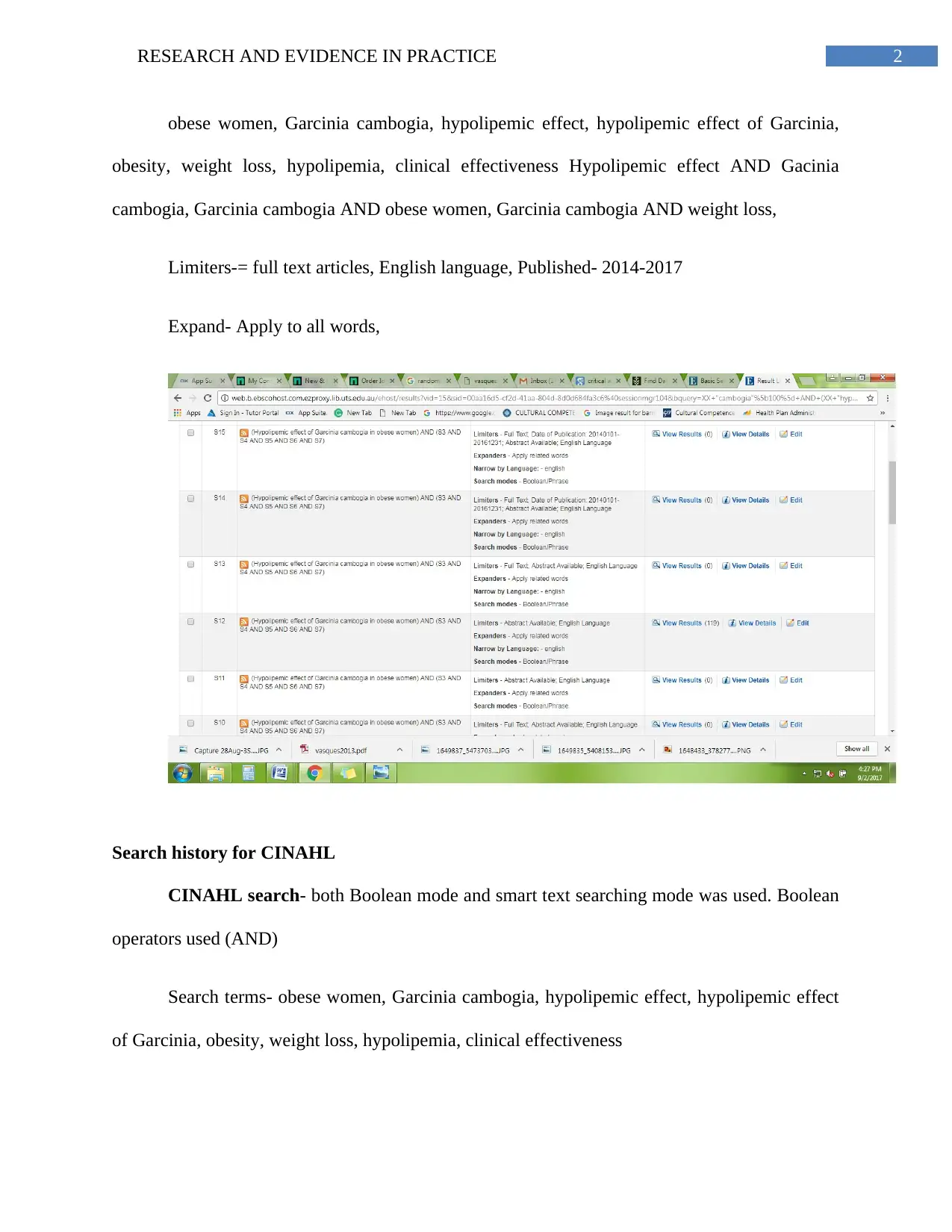
2RESEARCH AND EVIDENCE IN PRACTICE
obese women, Garcinia cambogia, hypolipemic effect, hypolipemic effect of Garcinia,
obesity, weight loss, hypolipemia, clinical effectiveness Hypolipemic effect AND Gacinia
cambogia, Garcinia cambogia AND obese women, Garcinia cambogia AND weight loss,
Limiters-= full text articles, English language, Published- 2014-2017
Expand- Apply to all words,
Search history for CINAHL
CINAHL search- both Boolean mode and smart text searching mode was used. Boolean
operators used (AND)
Search terms- obese women, Garcinia cambogia, hypolipemic effect, hypolipemic effect
of Garcinia, obesity, weight loss, hypolipemia, clinical effectiveness
obese women, Garcinia cambogia, hypolipemic effect, hypolipemic effect of Garcinia,
obesity, weight loss, hypolipemia, clinical effectiveness Hypolipemic effect AND Gacinia
cambogia, Garcinia cambogia AND obese women, Garcinia cambogia AND weight loss,
Limiters-= full text articles, English language, Published- 2014-2017
Expand- Apply to all words,
Search history for CINAHL
CINAHL search- both Boolean mode and smart text searching mode was used. Boolean
operators used (AND)
Search terms- obese women, Garcinia cambogia, hypolipemic effect, hypolipemic effect
of Garcinia, obesity, weight loss, hypolipemia, clinical effectiveness
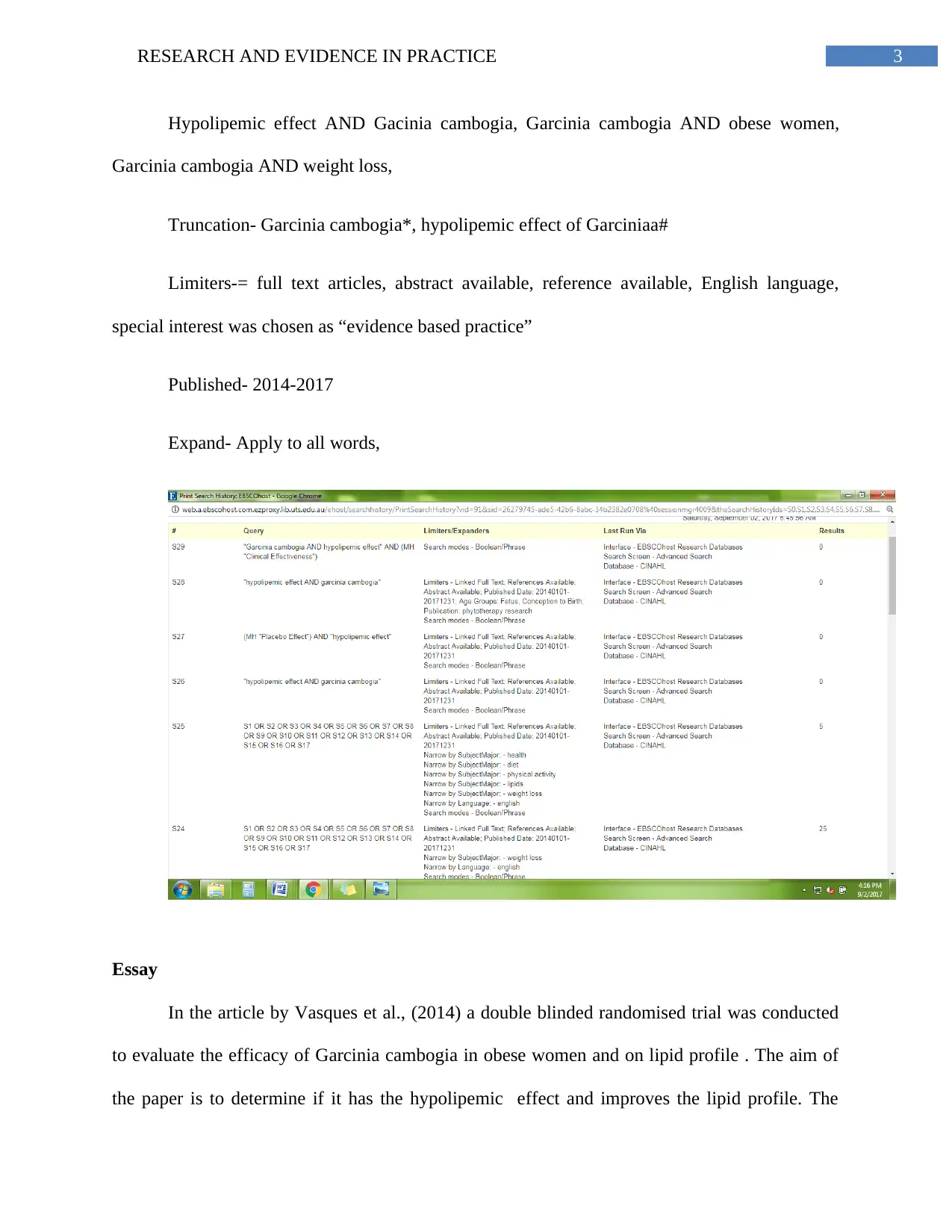
3RESEARCH AND EVIDENCE IN PRACTICE
Hypolipemic effect AND Gacinia cambogia, Garcinia cambogia AND obese women,
Garcinia cambogia AND weight loss,
Truncation- Garcinia cambogia*, hypolipemic effect of Garciniaa#
Limiters-= full text articles, abstract available, reference available, English language,
special interest was chosen as “evidence based practice”
Published- 2014-2017
Expand- Apply to all words,
Essay
In the article by Vasques et al., (2014) a double blinded randomised trial was conducted
to evaluate the efficacy of Garcinia cambogia in obese women and on lipid profile . The aim of
the paper is to determine if it has the hypolipemic effect and improves the lipid profile. The
Hypolipemic effect AND Gacinia cambogia, Garcinia cambogia AND obese women,
Garcinia cambogia AND weight loss,
Truncation- Garcinia cambogia*, hypolipemic effect of Garciniaa#
Limiters-= full text articles, abstract available, reference available, English language,
special interest was chosen as “evidence based practice”
Published- 2014-2017
Expand- Apply to all words,
Essay
In the article by Vasques et al., (2014) a double blinded randomised trial was conducted
to evaluate the efficacy of Garcinia cambogia in obese women and on lipid profile . The aim of
the paper is to determine if it has the hypolipemic effect and improves the lipid profile. The
Secure Best Marks with AI Grader
Need help grading? Try our AI Grader for instant feedback on your assignments.
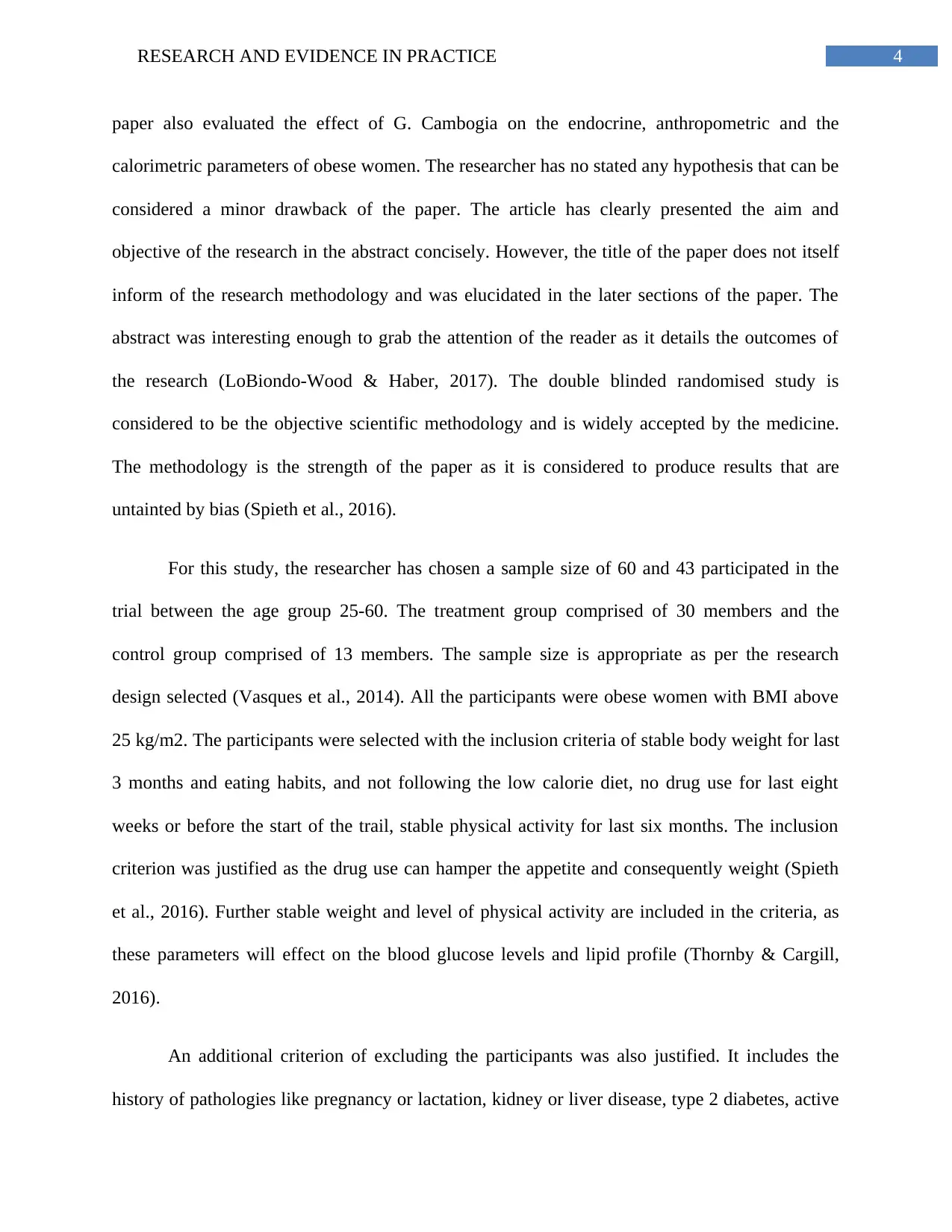
4RESEARCH AND EVIDENCE IN PRACTICE
paper also evaluated the effect of G. Cambogia on the endocrine, anthropometric and the
calorimetric parameters of obese women. The researcher has no stated any hypothesis that can be
considered a minor drawback of the paper. The article has clearly presented the aim and
objective of the research in the abstract concisely. However, the title of the paper does not itself
inform of the research methodology and was elucidated in the later sections of the paper. The
abstract was interesting enough to grab the attention of the reader as it details the outcomes of
the research (LoBiondo-Wood & Haber, 2017). The double blinded randomised study is
considered to be the objective scientific methodology and is widely accepted by the medicine.
The methodology is the strength of the paper as it is considered to produce results that are
untainted by bias (Spieth et al., 2016).
For this study, the researcher has chosen a sample size of 60 and 43 participated in the
trial between the age group 25-60. The treatment group comprised of 30 members and the
control group comprised of 13 members. The sample size is appropriate as per the research
design selected (Vasques et al., 2014). All the participants were obese women with BMI above
25 kg/m2. The participants were selected with the inclusion criteria of stable body weight for last
3 months and eating habits, and not following the low calorie diet, no drug use for last eight
weeks or before the start of the trail, stable physical activity for last six months. The inclusion
criterion was justified as the drug use can hamper the appetite and consequently weight (Spieth
et al., 2016). Further stable weight and level of physical activity are included in the criteria, as
these parameters will effect on the blood glucose levels and lipid profile (Thornby & Cargill,
2016).
An additional criterion of excluding the participants was also justified. It includes the
history of pathologies like pregnancy or lactation, kidney or liver disease, type 2 diabetes, active
paper also evaluated the effect of G. Cambogia on the endocrine, anthropometric and the
calorimetric parameters of obese women. The researcher has no stated any hypothesis that can be
considered a minor drawback of the paper. The article has clearly presented the aim and
objective of the research in the abstract concisely. However, the title of the paper does not itself
inform of the research methodology and was elucidated in the later sections of the paper. The
abstract was interesting enough to grab the attention of the reader as it details the outcomes of
the research (LoBiondo-Wood & Haber, 2017). The double blinded randomised study is
considered to be the objective scientific methodology and is widely accepted by the medicine.
The methodology is the strength of the paper as it is considered to produce results that are
untainted by bias (Spieth et al., 2016).
For this study, the researcher has chosen a sample size of 60 and 43 participated in the
trial between the age group 25-60. The treatment group comprised of 30 members and the
control group comprised of 13 members. The sample size is appropriate as per the research
design selected (Vasques et al., 2014). All the participants were obese women with BMI above
25 kg/m2. The participants were selected with the inclusion criteria of stable body weight for last
3 months and eating habits, and not following the low calorie diet, no drug use for last eight
weeks or before the start of the trail, stable physical activity for last six months. The inclusion
criterion was justified as the drug use can hamper the appetite and consequently weight (Spieth
et al., 2016). Further stable weight and level of physical activity are included in the criteria, as
these parameters will effect on the blood glucose levels and lipid profile (Thornby & Cargill,
2016).
An additional criterion of excluding the participants was also justified. It includes the
history of pathologies like pregnancy or lactation, kidney or liver disease, type 2 diabetes, active
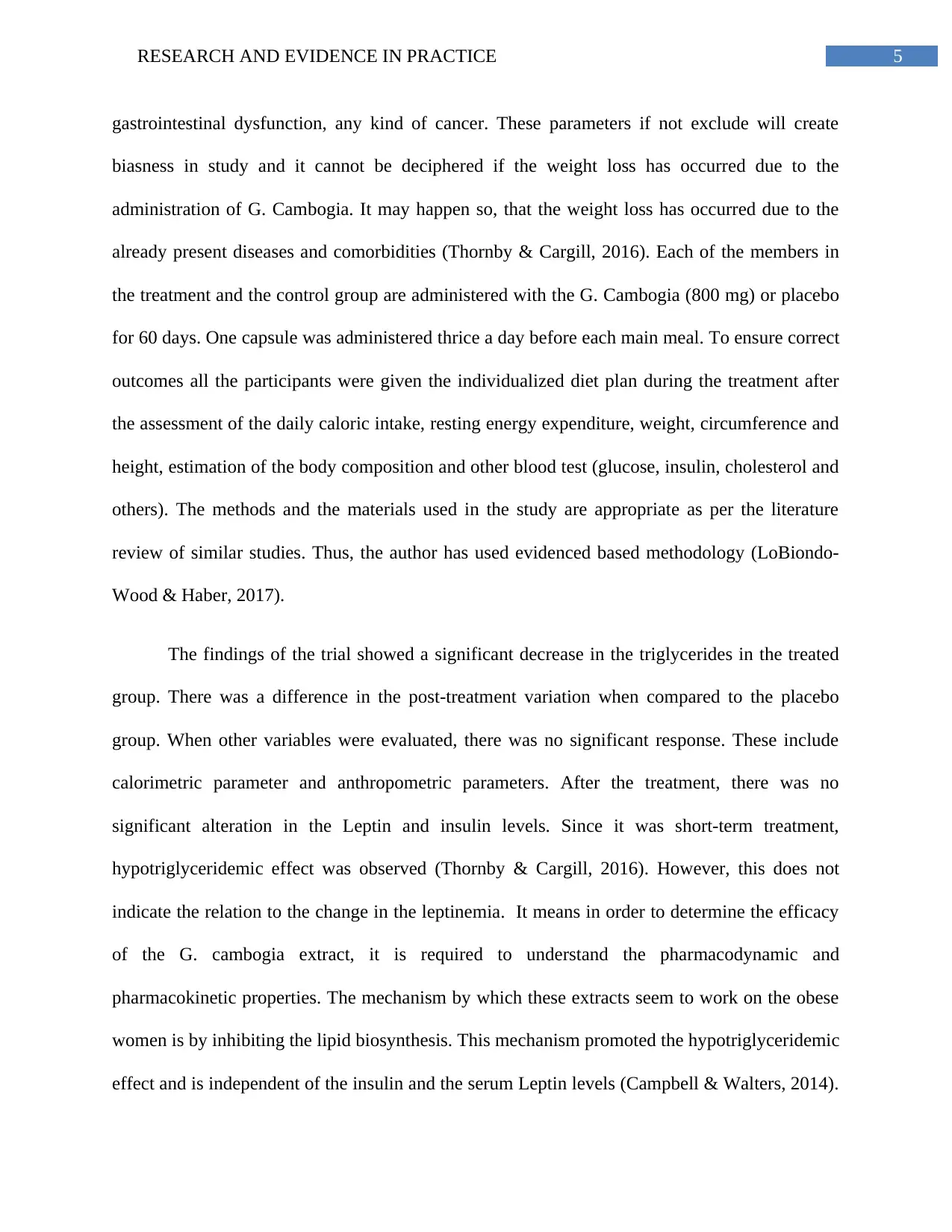
5RESEARCH AND EVIDENCE IN PRACTICE
gastrointestinal dysfunction, any kind of cancer. These parameters if not exclude will create
biasness in study and it cannot be deciphered if the weight loss has occurred due to the
administration of G. Cambogia. It may happen so, that the weight loss has occurred due to the
already present diseases and comorbidities (Thornby & Cargill, 2016). Each of the members in
the treatment and the control group are administered with the G. Cambogia (800 mg) or placebo
for 60 days. One capsule was administered thrice a day before each main meal. To ensure correct
outcomes all the participants were given the individualized diet plan during the treatment after
the assessment of the daily caloric intake, resting energy expenditure, weight, circumference and
height, estimation of the body composition and other blood test (glucose, insulin, cholesterol and
others). The methods and the materials used in the study are appropriate as per the literature
review of similar studies. Thus, the author has used evidenced based methodology (LoBiondo-
Wood & Haber, 2017).
The findings of the trial showed a significant decrease in the triglycerides in the treated
group. There was a difference in the post-treatment variation when compared to the placebo
group. When other variables were evaluated, there was no significant response. These include
calorimetric parameter and anthropometric parameters. After the treatment, there was no
significant alteration in the Leptin and insulin levels. Since it was short-term treatment,
hypotriglyceridemic effect was observed (Thornby & Cargill, 2016). However, this does not
indicate the relation to the change in the leptinemia. It means in order to determine the efficacy
of the G. cambogia extract, it is required to understand the pharmacodynamic and
pharmacokinetic properties. The mechanism by which these extracts seem to work on the obese
women is by inhibiting the lipid biosynthesis. This mechanism promoted the hypotriglyceridemic
effect and is independent of the insulin and the serum Leptin levels (Campbell & Walters, 2014).
gastrointestinal dysfunction, any kind of cancer. These parameters if not exclude will create
biasness in study and it cannot be deciphered if the weight loss has occurred due to the
administration of G. Cambogia. It may happen so, that the weight loss has occurred due to the
already present diseases and comorbidities (Thornby & Cargill, 2016). Each of the members in
the treatment and the control group are administered with the G. Cambogia (800 mg) or placebo
for 60 days. One capsule was administered thrice a day before each main meal. To ensure correct
outcomes all the participants were given the individualized diet plan during the treatment after
the assessment of the daily caloric intake, resting energy expenditure, weight, circumference and
height, estimation of the body composition and other blood test (glucose, insulin, cholesterol and
others). The methods and the materials used in the study are appropriate as per the literature
review of similar studies. Thus, the author has used evidenced based methodology (LoBiondo-
Wood & Haber, 2017).
The findings of the trial showed a significant decrease in the triglycerides in the treated
group. There was a difference in the post-treatment variation when compared to the placebo
group. When other variables were evaluated, there was no significant response. These include
calorimetric parameter and anthropometric parameters. After the treatment, there was no
significant alteration in the Leptin and insulin levels. Since it was short-term treatment,
hypotriglyceridemic effect was observed (Thornby & Cargill, 2016). However, this does not
indicate the relation to the change in the leptinemia. It means in order to determine the efficacy
of the G. cambogia extract, it is required to understand the pharmacodynamic and
pharmacokinetic properties. The mechanism by which these extracts seem to work on the obese
women is by inhibiting the lipid biosynthesis. This mechanism promoted the hypotriglyceridemic
effect and is independent of the insulin and the serum Leptin levels (Campbell & Walters, 2014).
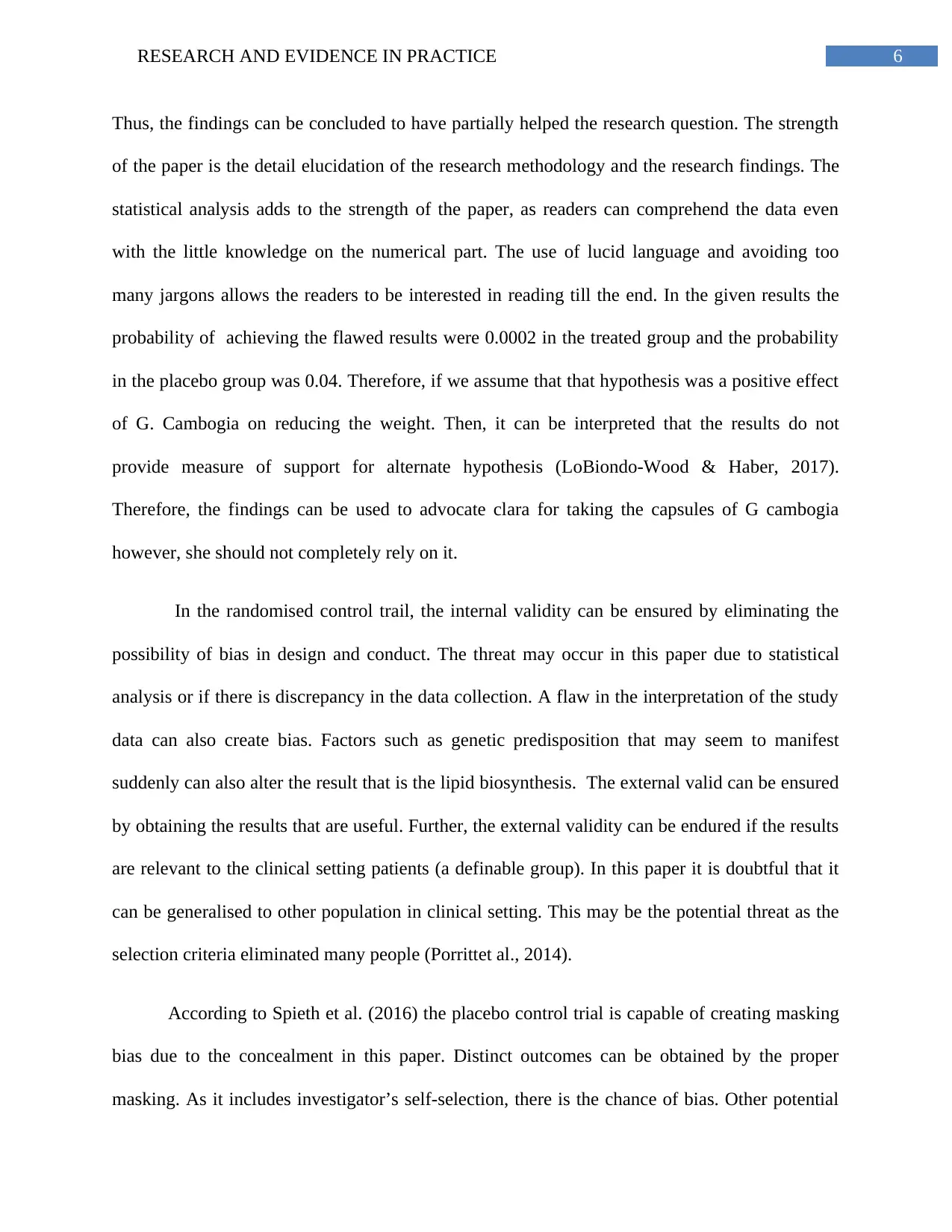
6RESEARCH AND EVIDENCE IN PRACTICE
Thus, the findings can be concluded to have partially helped the research question. The strength
of the paper is the detail elucidation of the research methodology and the research findings. The
statistical analysis adds to the strength of the paper, as readers can comprehend the data even
with the little knowledge on the numerical part. The use of lucid language and avoiding too
many jargons allows the readers to be interested in reading till the end. In the given results the
probability of achieving the flawed results were 0.0002 in the treated group and the probability
in the placebo group was 0.04. Therefore, if we assume that that hypothesis was a positive effect
of G. Cambogia on reducing the weight. Then, it can be interpreted that the results do not
provide measure of support for alternate hypothesis (LoBiondo-Wood & Haber, 2017).
Therefore, the findings can be used to advocate clara for taking the capsules of G cambogia
however, she should not completely rely on it.
In the randomised control trail, the internal validity can be ensured by eliminating the
possibility of bias in design and conduct. The threat may occur in this paper due to statistical
analysis or if there is discrepancy in the data collection. A flaw in the interpretation of the study
data can also create bias. Factors such as genetic predisposition that may seem to manifest
suddenly can also alter the result that is the lipid biosynthesis. The external valid can be ensured
by obtaining the results that are useful. Further, the external validity can be endured if the results
are relevant to the clinical setting patients (a definable group). In this paper it is doubtful that it
can be generalised to other population in clinical setting. This may be the potential threat as the
selection criteria eliminated many people (Porrittet al., 2014).
According to Spieth et al. (2016) the placebo control trial is capable of creating masking
bias due to the concealment in this paper. Distinct outcomes can be obtained by the proper
masking. As it includes investigator’s self-selection, there is the chance of bias. Other potential
Thus, the findings can be concluded to have partially helped the research question. The strength
of the paper is the detail elucidation of the research methodology and the research findings. The
statistical analysis adds to the strength of the paper, as readers can comprehend the data even
with the little knowledge on the numerical part. The use of lucid language and avoiding too
many jargons allows the readers to be interested in reading till the end. In the given results the
probability of achieving the flawed results were 0.0002 in the treated group and the probability
in the placebo group was 0.04. Therefore, if we assume that that hypothesis was a positive effect
of G. Cambogia on reducing the weight. Then, it can be interpreted that the results do not
provide measure of support for alternate hypothesis (LoBiondo-Wood & Haber, 2017).
Therefore, the findings can be used to advocate clara for taking the capsules of G cambogia
however, she should not completely rely on it.
In the randomised control trail, the internal validity can be ensured by eliminating the
possibility of bias in design and conduct. The threat may occur in this paper due to statistical
analysis or if there is discrepancy in the data collection. A flaw in the interpretation of the study
data can also create bias. Factors such as genetic predisposition that may seem to manifest
suddenly can also alter the result that is the lipid biosynthesis. The external valid can be ensured
by obtaining the results that are useful. Further, the external validity can be endured if the results
are relevant to the clinical setting patients (a definable group). In this paper it is doubtful that it
can be generalised to other population in clinical setting. This may be the potential threat as the
selection criteria eliminated many people (Porrittet al., 2014).
According to Spieth et al. (2016) the placebo control trial is capable of creating masking
bias due to the concealment in this paper. Distinct outcomes can be obtained by the proper
masking. As it includes investigator’s self-selection, there is the chance of bias. Other potential
Paraphrase This Document
Need a fresh take? Get an instant paraphrase of this document with our AI Paraphraser
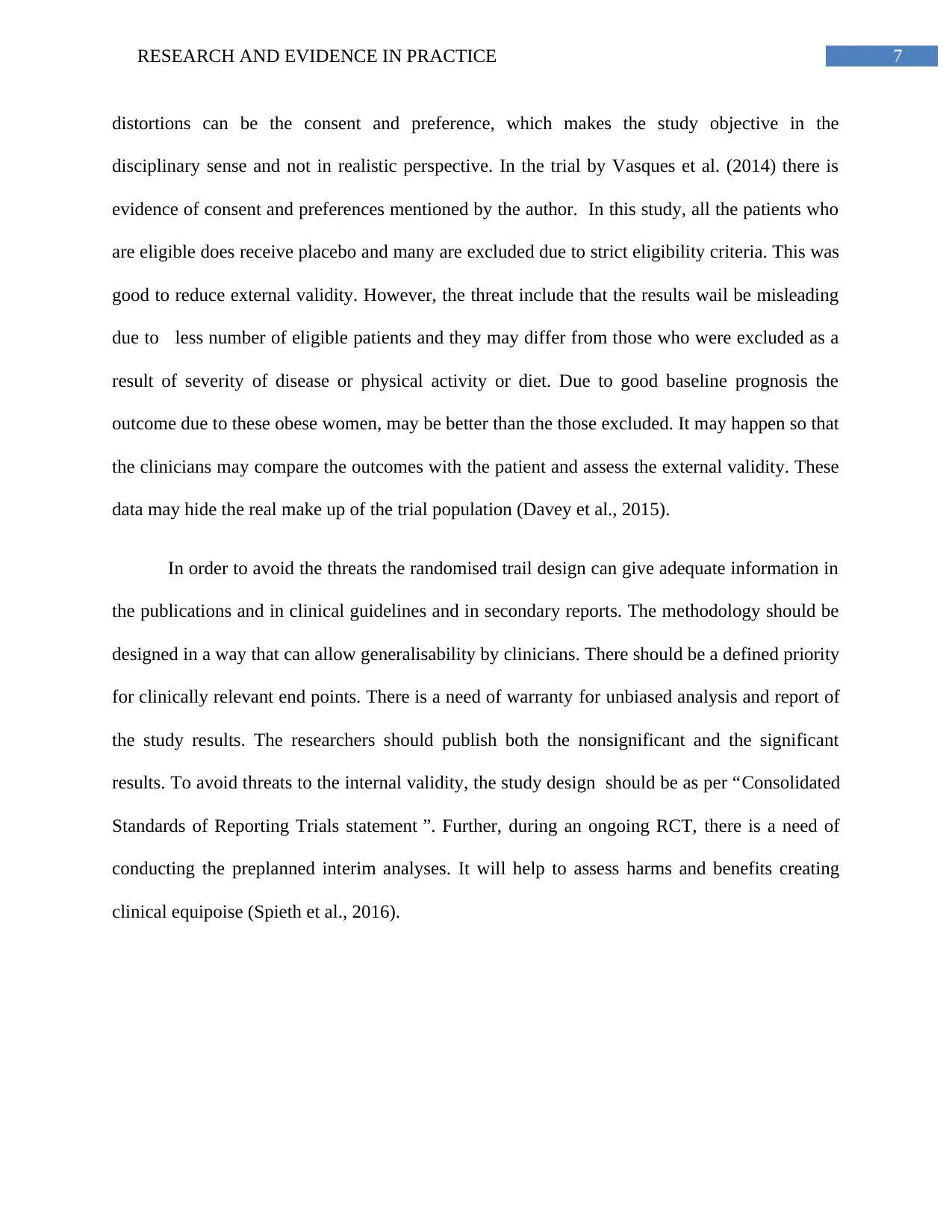
7RESEARCH AND EVIDENCE IN PRACTICE
distortions can be the consent and preference, which makes the study objective in the
disciplinary sense and not in realistic perspective. In the trial by Vasques et al. (2014) there is
evidence of consent and preferences mentioned by the author. In this study, all the patients who
are eligible does receive placebo and many are excluded due to strict eligibility criteria. This was
good to reduce external validity. However, the threat include that the results wail be misleading
due to less number of eligible patients and they may differ from those who were excluded as a
result of severity of disease or physical activity or diet. Due to good baseline prognosis the
outcome due to these obese women, may be better than the those excluded. It may happen so that
the clinicians may compare the outcomes with the patient and assess the external validity. These
data may hide the real make up of the trial population (Davey et al., 2015).
In order to avoid the threats the randomised trail design can give adequate information in
the publications and in clinical guidelines and in secondary reports. The methodology should be
designed in a way that can allow generalisability by clinicians. There should be a defined priority
for clinically relevant end points. There is a need of warranty for unbiased analysis and report of
the study results. The researchers should publish both the nonsignificant and the significant
results. To avoid threats to the internal validity, the study design should be as per “Consolidated
Standards of Reporting Trials statement ”. Further, during an ongoing RCT, there is a need of
conducting the preplanned interim analyses. It will help to assess harms and benefits creating
clinical equipoise (Spieth et al., 2016).
distortions can be the consent and preference, which makes the study objective in the
disciplinary sense and not in realistic perspective. In the trial by Vasques et al. (2014) there is
evidence of consent and preferences mentioned by the author. In this study, all the patients who
are eligible does receive placebo and many are excluded due to strict eligibility criteria. This was
good to reduce external validity. However, the threat include that the results wail be misleading
due to less number of eligible patients and they may differ from those who were excluded as a
result of severity of disease or physical activity or diet. Due to good baseline prognosis the
outcome due to these obese women, may be better than the those excluded. It may happen so that
the clinicians may compare the outcomes with the patient and assess the external validity. These
data may hide the real make up of the trial population (Davey et al., 2015).
In order to avoid the threats the randomised trail design can give adequate information in
the publications and in clinical guidelines and in secondary reports. The methodology should be
designed in a way that can allow generalisability by clinicians. There should be a defined priority
for clinically relevant end points. There is a need of warranty for unbiased analysis and report of
the study results. The researchers should publish both the nonsignificant and the significant
results. To avoid threats to the internal validity, the study design should be as per “Consolidated
Standards of Reporting Trials statement ”. Further, during an ongoing RCT, there is a need of
conducting the preplanned interim analyses. It will help to assess harms and benefits creating
clinical equipoise (Spieth et al., 2016).
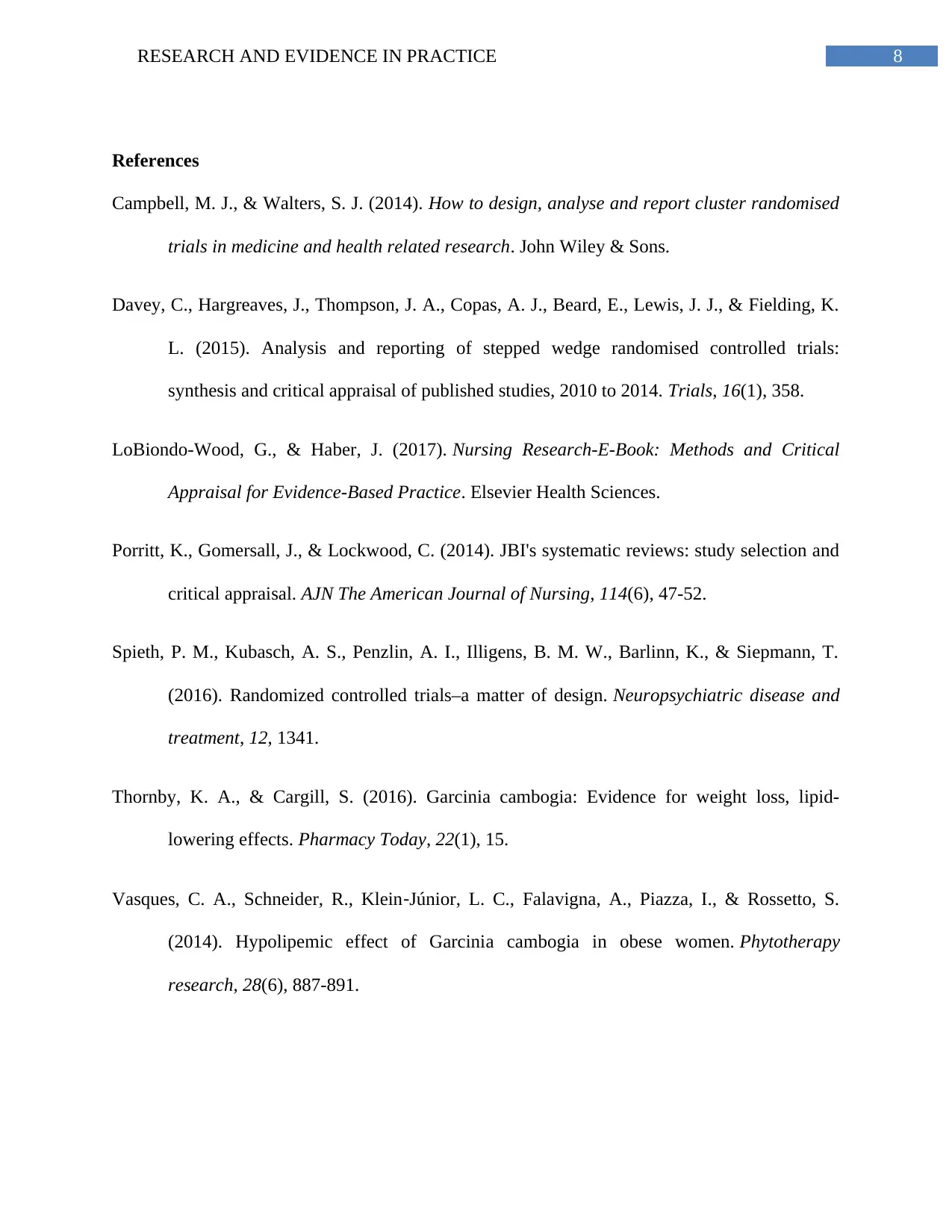
8RESEARCH AND EVIDENCE IN PRACTICE
References
Campbell, M. J., & Walters, S. J. (2014). How to design, analyse and report cluster randomised
trials in medicine and health related research. John Wiley & Sons.
Davey, C., Hargreaves, J., Thompson, J. A., Copas, A. J., Beard, E., Lewis, J. J., & Fielding, K.
L. (2015). Analysis and reporting of stepped wedge randomised controlled trials:
synthesis and critical appraisal of published studies, 2010 to 2014. Trials, 16(1), 358.
LoBiondo-Wood, G., & Haber, J. (2017). Nursing Research-E-Book: Methods and Critical
Appraisal for Evidence-Based Practice. Elsevier Health Sciences.
Porritt, K., Gomersall, J., & Lockwood, C. (2014). JBI's systematic reviews: study selection and
critical appraisal. AJN The American Journal of Nursing, 114(6), 47-52.
Spieth, P. M., Kubasch, A. S., Penzlin, A. I., Illigens, B. M. W., Barlinn, K., & Siepmann, T.
(2016). Randomized controlled trials–a matter of design. Neuropsychiatric disease and
treatment, 12, 1341.
Thornby, K. A., & Cargill, S. (2016). Garcinia cambogia: Evidence for weight loss, lipid-
lowering effects. Pharmacy Today, 22(1), 15.
Vasques, C. A., Schneider, R., Klein‐Júnior, L. C., Falavigna, A., Piazza, I., & Rossetto, S.
(2014). Hypolipemic effect of Garcinia cambogia in obese women. Phytotherapy
research, 28(6), 887-891.
References
Campbell, M. J., & Walters, S. J. (2014). How to design, analyse and report cluster randomised
trials in medicine and health related research. John Wiley & Sons.
Davey, C., Hargreaves, J., Thompson, J. A., Copas, A. J., Beard, E., Lewis, J. J., & Fielding, K.
L. (2015). Analysis and reporting of stepped wedge randomised controlled trials:
synthesis and critical appraisal of published studies, 2010 to 2014. Trials, 16(1), 358.
LoBiondo-Wood, G., & Haber, J. (2017). Nursing Research-E-Book: Methods and Critical
Appraisal for Evidence-Based Practice. Elsevier Health Sciences.
Porritt, K., Gomersall, J., & Lockwood, C. (2014). JBI's systematic reviews: study selection and
critical appraisal. AJN The American Journal of Nursing, 114(6), 47-52.
Spieth, P. M., Kubasch, A. S., Penzlin, A. I., Illigens, B. M. W., Barlinn, K., & Siepmann, T.
(2016). Randomized controlled trials–a matter of design. Neuropsychiatric disease and
treatment, 12, 1341.
Thornby, K. A., & Cargill, S. (2016). Garcinia cambogia: Evidence for weight loss, lipid-
lowering effects. Pharmacy Today, 22(1), 15.
Vasques, C. A., Schneider, R., Klein‐Júnior, L. C., Falavigna, A., Piazza, I., & Rossetto, S.
(2014). Hypolipemic effect of Garcinia cambogia in obese women. Phytotherapy
research, 28(6), 887-891.

9RESEARCH AND EVIDENCE IN PRACTICE
1 out of 10
Related Documents
Your All-in-One AI-Powered Toolkit for Academic Success.
+13062052269
info@desklib.com
Available 24*7 on WhatsApp / Email
![[object Object]](/_next/static/media/star-bottom.7253800d.svg)
Unlock your academic potential
© 2024 | Zucol Services PVT LTD | All rights reserved.





